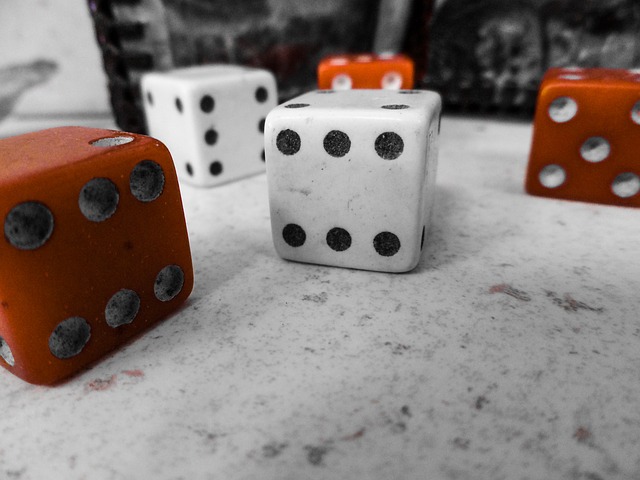Basic Concepts
Learning Outcomes
- Describe a sample space and simple and compound events in it using standard notation
- Calculate the probability of an event using standard notation
- Calculate the probability of two independent events using standard notation
- Recognize when two events are mutually exclusive
- Calculate a conditional probability using standard notation
 We begin with some terminology.
We begin with some terminology.
Events and Outcomes
- The result of an experiment is called an outcome.
- An event is any particular outcome or group of outcomes.
- A simple event is an event that cannot be broken down further
- The sample space is the set of all possible simple events.
example
If we roll a standard 6-sided die, describe the sample space and some simple events.Answer: The sample space is the set of all possible simple events: {1,2,3,4,5,6} Some examples of simple events:
- We roll a 1
- We roll a 5
- We roll a number bigger than 4
- We roll an even number
Basic Probability
Given that all outcomes are equally likely, we can compute the probability of an event E using this formula:[latex]P(E)=\frac{\text{Number of outcomes corresponding to the event E}}{\text{Total number of equally-likely outcomes}}[/latex]
examples
If we roll a 6-sided die, calculate- P(rolling a 1)
- P(rolling a number bigger than 4)
Answer: Recall that the sample space is {1,2,3,4,5,6}
- There is one outcome corresponding to “rolling a 1,” so the probability is [latex]\frac{1}{6}[/latex]
- There are two outcomes bigger than a 4, so the probability is [latex]\frac{2}{6}=\frac{1}{3}[/latex]
Answer: There are 20 possible cherries that could be picked, so the number of possible outcomes is 20. Of these 20 possible outcomes, 14 are favorable (sweet), so the probability that the cherry will be sweet is [latex]\frac{14}{20}=\frac{7}{10}[/latex]. There is one potential complication to this example, however. It must be assumed that the probability of picking any of the cherries is the same as the probability of picking any other. This wouldn't be true if (let us imagine) the sweet cherries are smaller than the sour ones. (The sour cherries would come to hand more readily when you sampled from the bag.) Let us keep in mind, therefore, that when we assess probabilities in terms of the ratio of favorable to all potential cases, we rely heavily on the assumption of equal probability for all outcomes.
Try It
At some random moment, you look at your clock and note the minutes reading. a. What is probability the minutes reading is 15? b. What is the probability the minutes reading is 15 or less?Cards
A standard deck of 52 playing cards consists of four suits (hearts, spades, diamonds and clubs). Spades and clubs are black while hearts and diamonds are red. Each suit contains 13 cards, each of a different rank: an Ace (which in many games functions as both a low card and a high card), cards numbered 2 through 10, a Jack, a Queen and a King.example
Compute the probability of randomly drawing one card from a deck and getting an Ace.Answer: There are 52 cards in the deck and 4 Aces so [latex]P(Ace)=\frac{4}{52}=\frac{1}{13}\approx 0.0769[/latex] We can also think of probabilities as percents: There is a 7.69% chance that a randomly selected card will be an Ace. Notice that the smallest possible probability is 0 – if there are no outcomes that correspond with the event. The largest possible probability is 1 – if all possible outcomes correspond with the event.
This video demonstrates both this example and the previous cherry example on the page. https://youtu.be/EBqj_R3dzd4Certain and Impossible events
- An impossible event has a probability of 0.
- A certain event has a probability of 1.
- The probability of any event must be [latex]0\le P(E)\le 1[/latex]
Licenses & Attributions
CC licensed content, Original
- Revision and Adaptation. Provided by: Lumen Learning License: CC BY: Attribution.
CC licensed content, Shared previously
- Math in Society. Authored by: Open Textbook Store, Transition Math Project, and the Open Course Library. Located at: http://www.opentextbookstore.com/mathinsociety/. License: CC BY-SA: Attribution-ShareAlike.
- dice-die-probability-fortune-luck. Authored by: jodylehigh. License: CC0: No Rights Reserved.
- Basics of Probability - events and outcomes. Authored by: OCLPhase2's channel. License: CC BY: Attribution.
- Basic Probabilities. Authored by: OCLPhase2's channel. License: CC BY: Attribution.
- Question ID 7130. Authored by: WebWork-Rochester, mb Lippman,David. License: CC BY: Attribution. License terms: IMathAS Community License CC-BY + GPL.

